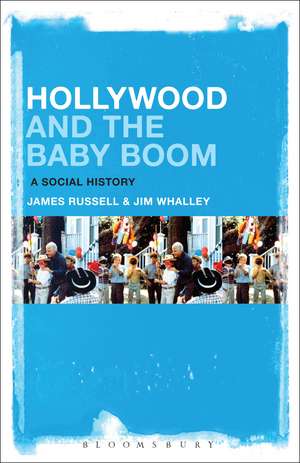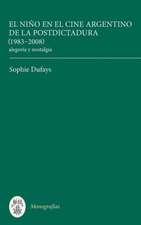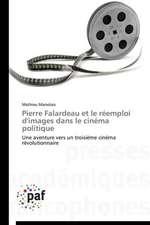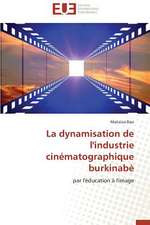Hollywood and the Baby Boom: A Social History
Autor Professor James Russell, Jim Whalleyen Limba Engleză Paperback – 26 iun 2019
| Toate formatele și edițiile | Preț | Express |
|---|---|---|
| Paperback (1) | 175.56 lei 3-5 săpt. | +25.76 lei 7-11 zile |
| Bloomsbury Publishing – 26 iun 2019 | 175.56 lei 3-5 săpt. | +25.76 lei 7-11 zile |
| Hardback (1) | 714.92 lei 6-8 săpt. | |
| Bloomsbury Publishing – 27 dec 2017 | 714.92 lei 6-8 săpt. |
Preț: 175.56 lei
Nou
Puncte Express: 263
Preț estimativ în valută:
33.59€ • 35.19$ • 27.84£
33.59€ • 35.19$ • 27.84£
Carte disponibilă
Livrare economică 18 martie-01 aprilie
Livrare express 04-08 martie pentru 35.75 lei
Preluare comenzi: 021 569.72.76
Specificații
ISBN-13: 9781501353901
ISBN-10: 150135390X
Pagini: 352
Ilustrații: 22 bw illus
Dimensiuni: 152 x 229 x 22 mm
Greutate: 0.47 kg
Editura: Bloomsbury Publishing
Colecția Bloomsbury Academic
Locul publicării:New York, United States
ISBN-10: 150135390X
Pagini: 352
Ilustrații: 22 bw illus
Dimensiuni: 152 x 229 x 22 mm
Greutate: 0.47 kg
Editura: Bloomsbury Publishing
Colecția Bloomsbury Academic
Locul publicării:New York, United States
Caracteristici
Includes extensive archival research in the USA with surveys of over 800 ordinary boomers' moviegoing experiences, and interviews with key baby boomer filmmakers, including Nancy Meyers, Ivan Reitman and Lawrence Kasdan
Notă biografică
James Russell is Principal Lecturer in Film Studies at De Montfort University, UK. His last book was The Historical Epic and Contemporary Hollywood (Bloomsbury, 2007). His short writing has appeared in Cinema Journal, the Journal of American Studies, the Guardian and numerous edited collections. Jim Whalley is an independent scholar based in the UK. He writes on American cinema history, and is the author of Saturday Night Live, Hollywood Comedy and American Culture (2010). His short writing has also appeared in The New Review of Film and Television Studies.
Cuprins
List of ImagesList of FiguresAcknowledgementsIntroduction Part 1. ChildhoodChapter One:Hollywood and the Baby Boom in the 1950sChapter Two: Watching MoviesChapter Three: On the Screen Part 2: YouthChapter Four: A Changing AudienceChapter Five: Movies and Youth RevoltChapter Six: Towards the Modern Blockbuster Part 3: SuccessChapter Seven: Boomer FilmmakersChapter Eight: Popular Genres and Popular Movies Part 4: MaturityChapter Nine: Mature MoviesChapter Ten: Families Forever Part 5: LegacyChapter Eleven: Franchise HollywoodConclusion. A Legacy Appendix A: The SurveyAppendix B:MPAA Age DemographicsBibliography
Recenzii
Drawing on a unique blend of primary sources (archival records, trade press reports, interviews with filmmakers and an online audience survey as well as a large number of films), this groundbreaking study offers a fresh account of the development of mainstream American cinema since the Second World War. Hollywood and the Baby Boom focuses on the impact, on cinemagoing and film production, of dramatically increased birth rates in the United States between the mid-1940s and the mid-1960s. The complex interaction between film industry strategies and generational turnover both in the audience and among Hollywood personnel is vividly brought to life by looking closely at some of the creative personnel shaping movies and at the experiences of a wide range of viewers. Thus, this engagingly written book has a lot to say about the important role that movies have played, and continue to play, in the lives of American baby boomers.
Meticulously researched and engagingly written, Hollywood and the Baby Boom offers an insightful account of the post war generation's profound impact on American cinema. Drawing on a range ofprimary sources - from archival materials to filmmaker interviews and audience surveys - James Russell and Jim Whalley provide fresh perspective on how baby boomers have influenced Hollywood's creative and executive decisions over the past fifty years. In doing so, they not only challenge common assumptions regarding the boomers' political and aesthetic tastes, but also force us to rethink standard historical narratives associated with contemporary Hollywood cinema.
Several film histories mention the baby boom and its impact on American cinema but none can claim to have examined it with the force, insight and detail of this wonderful new volume. Russell and Whalley navigate deftly through the annals of the last 70 years of Hollywood film history, which they re-read and re-write through the prism of new and exciting research materials, including interviews with filmmakers whose work has influenced that history. Hollywood and the Baby Boom reaches deep into the baby boom experience as this has shaped American cinema and as it was reflected in it, while also managing to present a complex and intricate historical account in a fresh, exciting and accessible manner. A real achievement!
In this excellent contribution to film studies, Russell and Whalley demonstrate how the effects of the baby boom are crucial to the reception and production of post-war American films. By combining historical perspectives and first person interviews, Hollywood and the Baby Boom challenges long-established histories of American cinema. This is an important text in developing the field that will have will have impact and influence beyond film studies, contributing valuable scholarship to American social history.
Meticulously researched and engagingly written, Hollywood and the Baby Boom offers an insightful account of the post war generation's profound impact on American cinema. Drawing on a range ofprimary sources - from archival materials to filmmaker interviews and audience surveys - James Russell and Jim Whalley provide fresh perspective on how baby boomers have influenced Hollywood's creative and executive decisions over the past fifty years. In doing so, they not only challenge common assumptions regarding the boomers' political and aesthetic tastes, but also force us to rethink standard historical narratives associated with contemporary Hollywood cinema.
Several film histories mention the baby boom and its impact on American cinema but none can claim to have examined it with the force, insight and detail of this wonderful new volume. Russell and Whalley navigate deftly through the annals of the last 70 years of Hollywood film history, which they re-read and re-write through the prism of new and exciting research materials, including interviews with filmmakers whose work has influenced that history. Hollywood and the Baby Boom reaches deep into the baby boom experience as this has shaped American cinema and as it was reflected in it, while also managing to present a complex and intricate historical account in a fresh, exciting and accessible manner. A real achievement!
In this excellent contribution to film studies, Russell and Whalley demonstrate how the effects of the baby boom are crucial to the reception and production of post-war American films. By combining historical perspectives and first person interviews, Hollywood and the Baby Boom challenges long-established histories of American cinema. This is an important text in developing the field that will have will have impact and influence beyond film studies, contributing valuable scholarship to American social history.






















